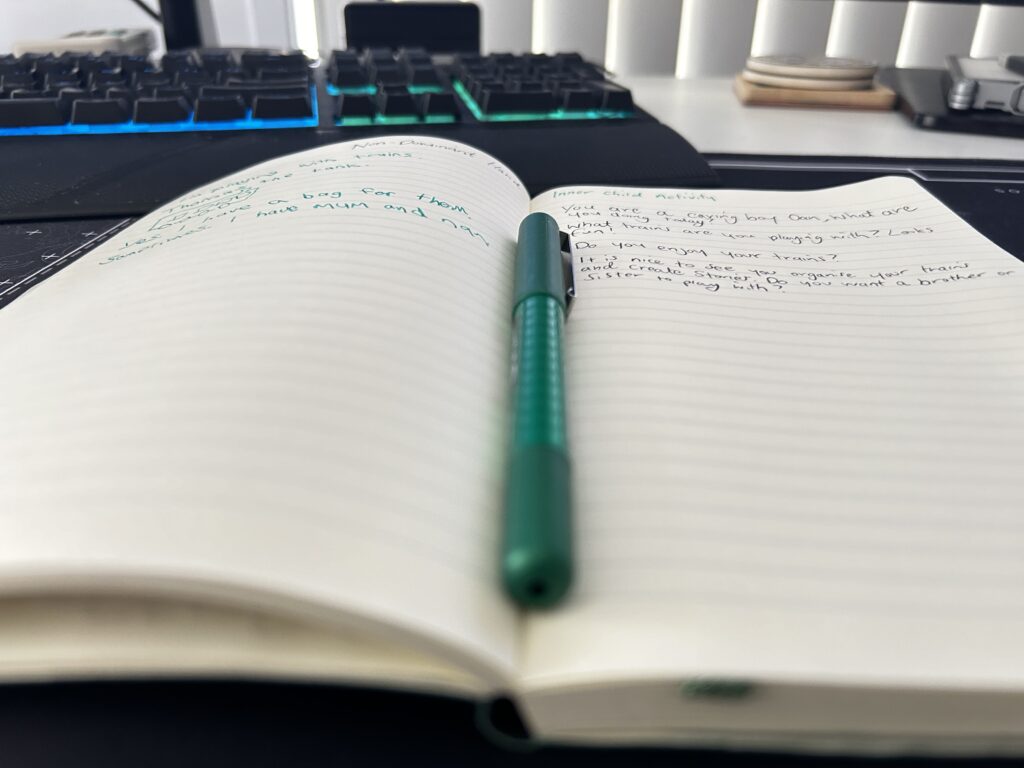Nurturing your inner child is a powerful step towards self-awareness and healing. At Meta Minds Therapy, we understand the importance of connecting with all parts of yourself, including the inner child. One effective technique for this is the Non-Dominant Hand Activity, which allows you to communicate with your inner child in a unique and profound way.
Writing to Your Inner Child
Writing using both hands to communicate with your inner child is both easy and safe. Remember, this is a serious activity and should not be treated as a party game. The inner child and other young selves you contact through this exercise need to be taken seriously.
Steps to Engage with Your Inner Child:
- Find a Quiet Space: Choose a place where you can be alone and free from interruptions. Turn off your phone to ensure a peaceful environment.
- Dominant Hand Writing: Begin by writing with your dominant hand. This represents the grown-up, more aware part of you. Write on the page that matches your dominant hand (right-handed individuals use the right page).
- Non-Dominant Hand Response: Use a different pen or pencil with your non-dominant hand and write on the opposite page. This hand represents your inner child. If you are right-handed, use your left hand and the left page.
- Positive Introduction: Start with your dominant hand, writing something positive about yourself and your inner child, like “You are…” or a reassuring welcome message addressed to your inner child by name.

- Free Expression: Using your non-dominant hand. Let your mind be free of analytical thoughts. Allow the pen or pencil to move as it wants—draw lines, doodle, or write freely.
- Gentle Response: Use your dominant hand to respond kindly to whatever your inner child expressed. Ask gentle, easy questions to encourage more dialogue.
- Ongoing Dialogue: Continue this back-and-forth as long as it feels right. You might spend half an hour or more, filling several pages.
- Be Compassionate: When writing as the grown-up, be gentle and understanding. Avoid being parental or pushy. Show your inner child the compassion and care that might have been lacking during your own childhood. This is crucial because many people carry wounds from their past, often stemming from a lack of love, understanding, and support.
- Child-Friendly Questions: Frame your questions in a child-friendly manner, avoiding logical or analytical “why” questions.
- Expect Childish Writing: The non-dominant hand will produce childish scrawl and possible spelling errors. Printing letters is acceptable if it helps.
- Young Inner Child: Your inner child may express through drawings or feelings, especially if very young.
- Language of Childhood: If English isn’t your first language, your inner child may write in your childhood language.

Showing Compassion and Care
It’s vitally important to show compassion and care to your inner child, especially if these were things you lacked in your own childhood. Many of us grow up with unmet emotional needs, and our inner child carries these wounds into adulthood. As you start to connect with your inner child through this activity, you may begin to reconnect with challenging memories from childhood. These memories can be painful, but they also offer an opportunity for healing.
As your wise adult self, you have the ability to show this part of yourself the love, compassion, and care that you needed but perhaps didn’t receive when you were younger. This process of self-compassion and re-parenting can be profoundly healing. It allows you to:
- Validate Your Experiences: Acknowledge the emotions and experiences of your inner child. This validation is essential for healing old wounds.
- Provide Reassurance: Offer comfort and reassurance to your inner child, letting them know that they are safe, loved, and understood.
- Heal Old Wounds: By addressing these past hurts with compassion, you can start to heal the emotional wounds that have affected you into adulthood.
- Build Self-Compassion: This practice helps to cultivate a deep sense of self-compassion, which is crucial for overall mental and emotional well-being.
- Foster Resilience: By nurturing your inner child, you strengthen your resilience, helping you to cope more effectively with current and future challenges.

Ending the Session
When concluding, close with a written ‘embrace’ from your dominant hand. Reassure your inner child that your grown-up self is there to love and protect them. This reassurance is particularly important if your inner child has expressed fear or vulnerability.
Mindful colouring can be a helpful way for you to regulate your emotions, reconnect with your playful inner child and ease your anxiety after doing the inner child non-dominant hand activity.

Historical Context
The technique of writing with opposite hands to communicate with the inner child has been around for over 25 years. In 1988, Linda Capacchione published ‘The Power of Your Other Hand’, and in 1991, ‘Recovery of Your Inner Child’, which includes fascinating case studies. Michael Rowland also recommends this technique, calling it ‘ambidextrous writing’.


